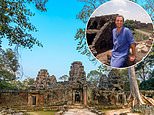
In our regular series, household names revisit the favourite holiday destinations of their youth. This week, the travel writer and historian William Dalrymple returns to Angkor Wat…
I first went to Angkor Wat in 1994 with my wife, and our three very young childen aged three to eight, when it was newly-liberated from the Khmer Rouge.
Modern-style tourism was just getting started in Cambodia and we were among the first guests to stay at the recently-opened Aman Resort at nearby Siem Reap, home to the then newish airport.
The first thing that struck me about Angkor Wat all those years ago was the magnificence of the Hindu temple complex – one of the richest archaeological landscapes and perfect ruined wonders anywhere in the world.
It’s up there with the Pyramids.
I was also bowled over by the sheer scale of the site, which is around four times the size of the Vatican City.
The temple complex dates back to the 12th century, when the Khmer Empire ruled Cambodia and neighbouring Laos, Vietnam and Thailand.
Some of the more outlying, overgrown ruins appeared in the film Lara Croft: Tomb Raider (2001), starring Angelina Jolie.
We also got to see the most incredible wildlife such as geckos and snakes – close enough to be exciting, but distant enough to not be scary – in the surrounding lush, green landscape.
Scottish historian William Dalrymple visits Angkor Wat, in Cambodia, where he first visited in 1994 with his wife and three young children, when it was newly liberated from the Khmer Rouge
‘The first thing that struck me about Angkor Wat all those years ago was the magnificence of the Hindu temple complex – one of the richest archaeological landscapes and perfect ruined wonders anywhere in the world,’ says William
Angkor Wat’s Hindu temple complex dates back to the 12th century, when the Khmer Empire ruled Cambodia and neighbouring Laos, Vietnam and Thailand
Another highlight was being able to listen to the sound of the jungle at night – a magical experience.
However, memories of the Khmer Rouge were still fresh, and the trip we made as a family to the zoo at Siem Reap turned out to be more sinister than we anticipated…
I hadn’t realised that that the Khmer Rouge had fed dozens of people to the crocodiles at the very same site.
So when we stood behind the barrier on the viewing platform, the crocodiles in the lagoon below greedily eyed me in the hope of getting some ‘fresh young meat’ – my children!
Thankfully for my kids, who are now grown-up, the crocs were to be disappointed.
In the years since, Angkor Wat has become popular with backpackers and newly-rich Chinese travellers.
But thankfully my return trip – to research my latest book – took place shortly after we had emerged from the pandemic, so it was quieter than usual.
Being on my own this time round, I was able to spend longer exploring the temple sites, and also enjoyed the delicious Cambodian cuisine – a cousin of Thai food, but much better in my opinion.
A cousin of Thai food, William is particularly fond of Cambodian cuisine – which he was able to enjoy more of on his return trip, unhampered by his children
William is particularly fond of traditional Cambodian noodle soups such as Ka Tieu, a staple breakfast dish and the nation’s ultimate comfort food
I particularly love their noodley soups.
If you have time, you could spend a week exploring Angkor Wat and the other temple complexes a three-four hour drive away – there’s a whole world of ruins in the jungle to explore, if you’re prepared to jump on a motorbike.
This was impossible to do in the 1990s because these areas were still dotted with land mines.
I’m sure I was a terrible parent in some respects, but the one thing I did do was take my kids to the most amazing places when they were young.
And of all the places they visited, the one they remember best was Angkor Wat. That says it all really, doesn’t it?
‘The Golden Road’, by William Dalrymple, is out now in paperback, £12.99. Also available as an audiobook.
Source link
CHECK OUT: Top Travel Destinations
READ MORE: Travel News



